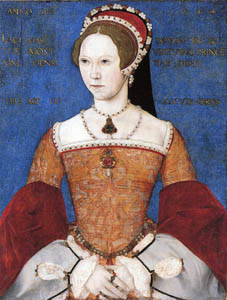On This Day: Birth of Mary I
Posted on
On this day 1516 Catherine of Aragon, Queen of England, gave birth to a baby girl at Greenwich. The girl was Catherine's fifth child by her husband King Henry VIII, but the four previous pregnancies had resulted in miscarriages, stillbirths, and one son who died after two weeks.
The Only Child
Catherine of Aragon married her brother-in-law, the new King Henry VIII, in June 1509. She fell pregnant quickly, but the baby girl was born prematurely in 1510 and was probably stillborn. In January 1511 she gave birth to a baby boy, who was promptly named Henry and was given the title "Duke of Cornwall", which was a traditional title for the heir to the English throne. The baby appears to have been healthy, he was christened four days after his birth but this wasn't unusual in a society that had a high infant mortality rate. Sadly though he died when he was nearly eight weeks old. No cause of death was ever recorded, but with the high number of illnesses and untreatable infections that were prevalent at the time, it's not unusual that a cause could not be found.
A third son, again called Henry, was born in November 1513. Unlike his brother this little boy didn't live longer than a few hours as he was premature. A third son was stillborn in early 1515, and does not appear to have been named. Mary's birth and survival in 1516, therefore, were seen as an important sign that it was indeed possible for Catherine and Henry to have a healthy child. Two years later Catherine gave birth to a third daughter, but this time the little girl lived no more than a week. This left Mary as Henry's only surviving child, and during her childhood she was an only child, doted on by her mother, who arranged her education.
A Little Sister
While Catherine may have reconciled herself to only have a daughter, Henry was less agreeable. He treated his daughter as a Princess of Wales, even sending her out to Wales to rule as his older brother Arthur had done, but he never formally gave her the title, which would have been an indication that she would be recognised as his heir. Mary had an illegitimate half-brother, Henry FitzRoy, whose presence suggested to her father that any problems with having children didn't stem from him. He was probably already thinking about divorcing Catherine when he met Anne Boleyn, but the fact that his new favourite refused to become his mistress probably prompted him to look closer in to the detail.
Mary and Catherine were devastated by Henry's actions, and both of them suffered. Mary was frequently ill, but was kept away from her mother by Henry, who refused to let the two women write to each other, let alone see one another. Mary was seventeen when Henry married Anne Boleyn, and the announcement of her pregnancy followed by her coronation were two further blows. Mary was declared illegitimate, and forbidden to use the title "Princess", although she could possibly derive some comfort from the fact that Anne Boleyn gave birth to a baby girl, not the son that was expected. At least this was a healthy child who thrived, showing Henry that healthy children were possible, it was unfortunate for Anne that all of her following pregnancies would end in miscarriages. None of it helped Mary though, who was not only devastated by the death of Catherine in 1536, but who was also estranged from her father as she consistently refused to acknowledge his belief that she was illegitimate.
A Little Brother
After Anne Boleyn's execution Henry married his third wife, Jane Seymour. The new Queen was seen as a pacifying influence, and she helped bring a reconciliation of sorts between Henry and Mary. Unfortunately it was at the cost of Mary's principles, she had to accept her father's declaration that she was illegitimate and that her parents had never been married. She was frequently ill, but she was more welcome at court than she had been. Jane argued behind the scenes for Mary to be reinstated in the line of succession, which was unsuccessful, but she did at least manage to have her step-daughter brought back to court. She was granted her own household, given several palaces to call her home, and Henry arranged for her to have her own income so she was free to buy her own clothes and pay for her own entertainments. Letters between her and Queen Jane show that she appreciated her step-mother's help, but they never grew particularly close as Jane died giving birth to a son, Edward, in 1537. Mary's return to court meant that she was now the principal woman in the kingdom, and as such she was both godmother to her little brother, and the chief mourner at Queen Jane's funeral.
Her life may have been promising at the start, but by the time she was in her early twenties, Mary's life had fallen apart. Her life would continue in a series of rollercoaster-like ups-and-downs. But five hundred years ago today, her parents would simply have been relieved that she was alive.
If you're a fan of Mary, you can check out her badge!